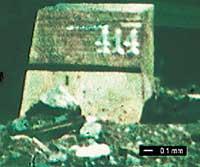Photos without silver

The new method has displaced silver to acids. Working with acids, they have managed to create the photo in a single step, reducing the use of chemical compounds. And not only that, but it offers the possibility to dramatically expand photos without losing transparency. See the photo of the train they have shown as an example.
After seeing such a surprising, though unbelieving, result, you will be wishing to know the details, but before explaining the details of the new method, better remember the bases of photography. In short, both processes are not so different.
Silver, base of the photo
The light and silver salts are the basis of photography for 200 years. The heart of photographic films are silver halide crystals. When you press the camera button and let the light reach the film, a photochemical reaction occurs: the salts become metallic silver. In very lit areas will be created a lot of silver and vice versa in poorly lit areas. In this way, a photo draft will be created in the film.


When the film is colored, the only layer of silver salt is replaced by three. Each layer is sensitive to a primary color, blue, green and red in photography, which means that the salts of each layer will only be transformed into metallic silver when they receive the corresponding color light. The rest of the colors are synthesized from them when all the photographs are made and the film is revealed.
Before revealing, it is said that in the film there are deaf photos instead of photos, because they are not completely defined, because they are like a draft. Precisely, the first step in the laboratory is to define the photographs completely, converting more silver salt into metallic silver. The reaction is carried out by closely controlling time, temperature and agitation, reinforcing the photographic path but avoiding the deterioration of the photo. Once the photo is correctly defined in negative, the process of development stops and the negatives are cleaned.
The photographs of the negatives are made in a similar way, projecting the images in papers coated with silver salts and following the same procedure described.
In the case of color films, the process has the same mechanics, but it is more complex, since more solutions are needed, it is done in total dark and once fixed the colors you must remove all the silver to the photos.
Acid instead of silver
Photography has long been looking for some method that replaces silver. The best would be a single-stage system, preferably without adding or removing any chemical reagent. Currently there are dry development processes, but these also use silver salts that, like conventional ones, require a great control.

The method presented by Polaroid discards silver and creates photographs from acids. The structure of the paper is similar to the traditional one, with layers sensitive to the three primary colors, but in this case the three layers are duplicated. Polaroid chemicals have prepared a two-layer system for each color. One of them contains light-sensitive components and another with acid-sensitive dyes. The image is formed in this second layer.
The new system takes advantage of light and heat. In the first step light is used to decompose the iodine salts of the first layer and obtain a strong acid. The paper is then heated to activate a chemical compound of the second layer. This and robust acid cause the synthesis of a weaker acid, which passes to the second layer and turns its dyes into colors.

Once the image is created, only the process of development remains thanks to a base that neutralizes the acids. The base is generated when the paper is heated and spread from the second layer to the first layer. By extending more slowly, acids have enough time to create the photo before being neutralized.
According to the researchers, this method allows to avoid problems of overexposure to the development.
Unfortunately, for the moment it is not very sensitive to visible light, but it can be ideal for working with laser or diodes. According to researchers, it is faster than inkjet printers and is suitable for printing images on digital cameras. At the industrial level, for their part, they consider that it can serve to create templates for printing newspapers. But in normal cameras we have to continue with the movies of always.





